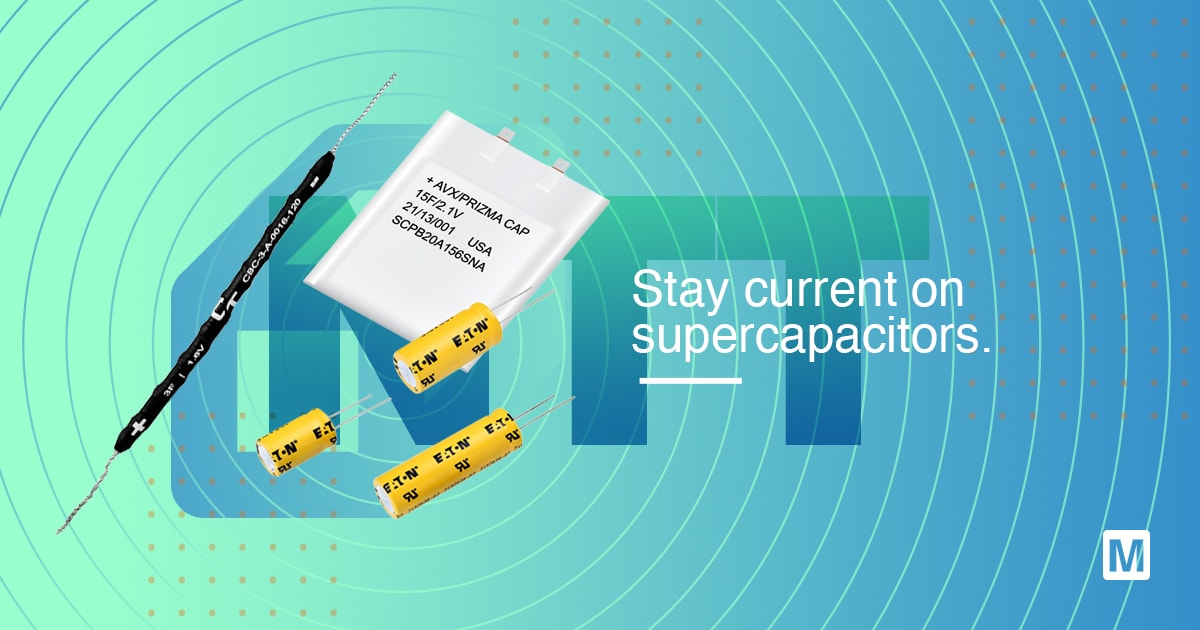Supercapacitors Store Energy and Have Several Other Advantages
New Tech Tuesdays
Join journalist Tommy Cummings for a weekly look at all things interesting, new, and noteworthy for design engineers.
Published October 11, 2021
If you’ve ever driven a newer-model hybrid or electric vehicle, you probably noticed that once the vehicle comes to a stop, the engine goes into a type of hibernation mode, like it's taking a breather. Then, as you tap the accelerator, the vehicle powers up as fast as it powered down, ready to roll.
This is the work of a supercapacitor, and it’s only one example of its many applications. In hybrids or EVs, supercapacitors are built to increase efficiency with energy storage. A single supercapacitor can store more energy than a conventional capacitor with a solid dielectric, but the storage capacity isn't on the scale of a battery.
It’s when a supercapacitor can store sufficient energy for an application that the advantages emerge—including the ability to instantaneously power up, charge quickly, and require less-complicated charging circuits.
This is important for design engineers, looking for advantages over batteries in consumer electronics, computers, and communications applications. They’re looking for supercapacitors with high power densities and long lifetimes regardless of the number of charge cycles.
You’ll find them in applications for Internet of Things (IoT) devices, smartphones, wearables, emergency lighting, renewable energy systems, uninterruptible backup power supplies, solar arrays, and energy harvesting technologies.
On a larger scale, supercapacitors are found in transportation applications such as magnetic levitation (maglev) trains, power and breaking recuperation systems, truck lifts, and track switching.
In this week's New Tech Tuesdays, we’ll look at a diverse range of supercapacitors from PowerStor/Eaton, AVX, and Capacitech.

They’re Small, But Powerful
PowerStor/Eaton TVA AEC-Q200 Supercapacitors are ideal for smart automotive and hybrid vehicle applications. These supercapacitors are ultra-high capacitance energy-storage devices that use electric double-layer capacitor (EDLC) construction combined with proprietary materials and processes. This combination allows capacitor solutions for backup power, pulse power, and hybrid power systems. You'll find them working with EV door locks and trunk latches, e-call applications, car video recorders, and broadnet stabilization systems. Broadnet stabilization provides balance in power utilization between interconnected and dynamic loads in power distribution systems. And true to their application: They’re made from environmentally friendly materials for a green power solution.
AVX PrizmaCap™ Capacitors are small-form devices that can be used alone or in conjunction with primary or secondary batteries. They are engineered to provide peak performance in several Size, Weight, Power, and Cost (SWaP-C)-optimized battery-powered products. The capacitors provide extended backup time, longer battery life, and instantaneous power pulses as needed. They are best used in applications requiring pulse power handling, energy storage, energy/power holdup, and battery assist. The series is particularly suited for use in end products, including wearable and handheld devices, industrial equipment, wireless keyboards, power peripherals, tablets, and e-readers. Design engineers will appreciate their operating temperature range (-55°C to +90°C), capacitance (3.5F–15F), and energy density (1.14Wh/kg–2.43Wh/kg).
Capacitech Cable-Based Capacitor (CBC) is a flexible, wire-shaped, twist-tie-like supercapacitor. Its discrete size gives it an advantage on printed circuit boards and is integrated into such devices as wearables, wiring harnesses, or power cards. On a PCB, the capacitor can be routed through areas where space is available or bent inside small enclosures. Designers can use CBCs together in series and/or parallel to meet a product’s specifications. This enables designers the opportunity to tailor smaller products, higher-performance products, or products with new features and capabilities by using the CBC off the PCB.
Tuesday’s Takeaway
In the past, supercapacitors were mostly for memory protection and internal battery backup. But their usage has broadened to include hybrid vehicles, smartphones, and energy harvesting. Look for their development to include even more applications in the coming years.